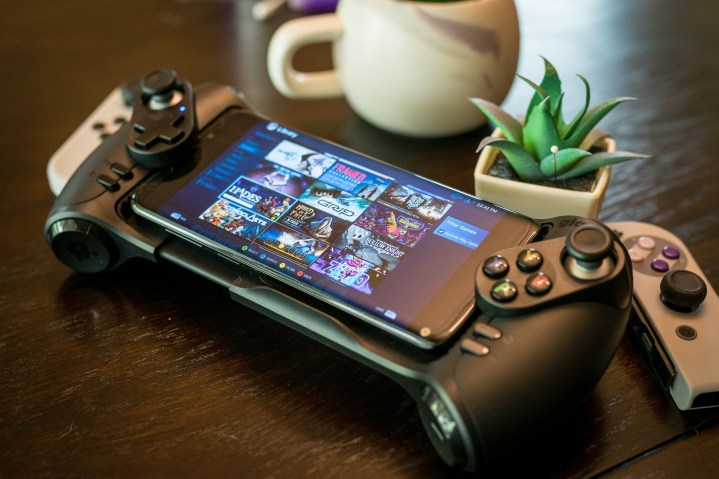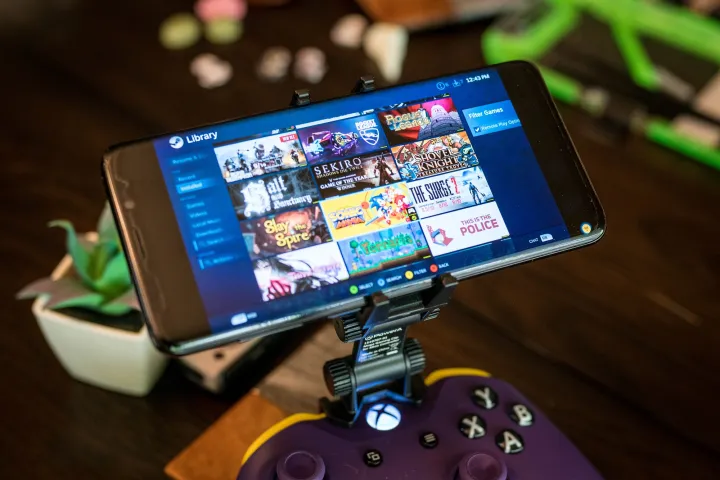The Nintendo Switch is an incredible console, allowing you to play full, fat console games no matter if you’re on the couch or on a plane. Although its portability is impressive and some of the more demanding titles are novel, there’s no denying how underpowered the Switch is. Most modern smartphones have better specs and are able to run Android while playing games.
If you have a gaming computer, though, you can harness its power to play games portably on your phone — not just from home, but when out and about, too. In this guide, we’ll show you how to set up remote play on your local network and external networks, as well as how to get the look and feel of a Switch.
Two notes before diving in: We’re going to get technical, so if you’re not up for the task, it’s best just to stick with a Switch. More importantly, though, you won’t get the same experience with your phone and PC as you will with a Switch. This setup works best on local networks and has an inconsistent ability to play outside your home. It isn’t perfect, and you’ll always be at the mercy of your connection, so keep that in mind.
Configuring for local play
Playing on your local network is easy. Download the Steam Link app to your phone, connect a Bluetooth controller or use the touch controls, and connect your PC. As long as your PC is hardwired and you have a decent connection, you should be able to stream games locally without many problems.

There are a couple of important notes for the best experience, though. You’ll obviously need a fast internet connection (25Mbps usually does the trick, though faster is better), but Wi-Fi won’t cut it. Your host machine must be hardwired. Although you can connect and launch a game with a host on Wi-Fi, your experience will likely be filled with stutters, lag, and streaming artifacts.
You can’t get away with Wi-Fi even if your connection is great. Hardwired connections are faster, and that’ll help with streaming quality. More important, though, hardwired connections are consistent. Wi-Fi is susceptible to interference from a slew of different sources, leading to wildly different results each time you connect to your host machine.
Simply downloading the Steam Link app doesn’t offer the full Switch experience. That’s where wake on LAN ( WoL) comes in. If you want to, say, plop down on the couch and boot up a game, you’d normally need to go and turn on your computer first. Thankfully, you can accomplish that remotely.
WoL allows your computer to detect when a certain packet is sent to the LAN port, essentially leaving your computer on standby. Although the power is still off, you can trigger your computer to wake by sending what’s known as a “magic packet.” Your computer will detect the packet and cause the “power on” cycle to start.
Enabling WoL is dead simple, too. Open the Device Manager in Windows and find your network adapter. Right-click and select Properties. Tab over to the Advanced section. Scroll down the list of options until you find Wake on LAN or something similar. In our case, it was Wake on Magic Packet. Enable this feature, and you should be good to go.

You may have to enable WoL in your BIOS, too. If you don’t know how to get to your BIOS, restart your computer. During the boot sequence, continually press the Delete key to open the BIOS screen. Where the setting is located will depend on your motherboard manufacturer, so consult the manual if you can to find where it’s buried.
Steam Link is capable of sending a magic packet, meaning as long as you have WoL enabled in Windows, you can boot your machine and start playing games right from your phone. The only other hurdle to overcome is signing into Windows. You can disable sign-in in the control panel, or you can struggle trying to enter your password with touch controls. It’s up to you — just make sure that Steam is set to run as a startup app so you can boot right into it when you wake your machine.
Connecting remotely
The connecting remotely part is where things get tricky. Most modern routers have security features built-in, meaning you can’t just connect to them from any ol’ network. Your router will block the connection — and that’s a good thing. If your router was totally open, anyone could connect to your local network remotely.
Steam Link still works on external networks, though you’ll need to forward a few ports on your router to get it working (UDP 27031, UDP 27036, TCP 27036, and TCP 27037). Essentially, Steam Link connects over those ports, so you forward them to your host PC so you can connect to it from a different network.
Thankfully, there’s a more elegant solution: Parsec. There are other remote desktop apps like Teamviewer, though Parsec’s focus on gaming makes the overall process smoother. Parsec lets you connect to any computer remotely, and it’s shockingly simple to use. Download the app on your host machine and your phone, create an account, and you’re good to go.

You may still need to set up port forwarding, and Parsec offers an extensive guide on how to do so. We didn’t need to, though. Even connecting over LTE, we booted into the host machine without any issues. Furthermore, Parsec has much better on-screen controls, meaning Windows sign-in is a breeze.
WoL is still possible with this setup, just not with Parsec. Thankfully, there are plenty of apps on Android that do WoL. In most cases, these apps can pick up the host machine as long as it and your phone are connected to the local network. You may have to manually input your computer’s IP address and MAC address, though.
That’s it for connecting remotely. Download Parsec, run WoL to power on your computer, and connect to your host machine. We won’t sugarcoat it, though: WoL isn’t perfect, and it has a hard time when triggering remotely. There were a few cases where our host machine simply didn’t pick up the packet and, thus, didn’t boot. In the majority of cases, though, we encountered few issues.
Getting the look

With the technobabble out of the way, let’s talk aesthetics. One of the most appealing aspects of the Switch is its form factor, and, thankfully, you can get a similar experience with your phone. There are several telescopic controllers that wrap around your phone, essentially sandwiching your screen between two sides of a controller.
Most of them are bad, though, as mobile emulator enthusiasts figured out years ago. With the release of the Switch, however, larger companies have started developing counterparts for mobile devices. There’s the Razer Junglecat, as well as the glap Play p/1 (pictured above). Of the two, the Junglecat is better if you have a supported device. The glap controller works with a wider range of devices, though, so that’s the one we used.
Razer is working on a similar controller called the Kinshi that will be compatible with a wider range of devices. It’s not out at the time of writing, though.
The Junglecat and Play p/1 are expensive, coming in around $100 each. There are a lot of cheaper alternatives on AliExpress and Amazon, though we advise against them. The build quality is usually bad, fit with sticky buttons and trigger dead zones. The setup described above is already temperamental, so there’s no reason to add controller frustration on top of that.

If cost is a concern, know that a phone clip and Xbox One controller gets the job done better than even the Junglecat. It doesn’t look the part of a Switch, sure, but it’s cheap and fast. It’s also much easier to take apart and clean an Xbox One controller should you need to.


